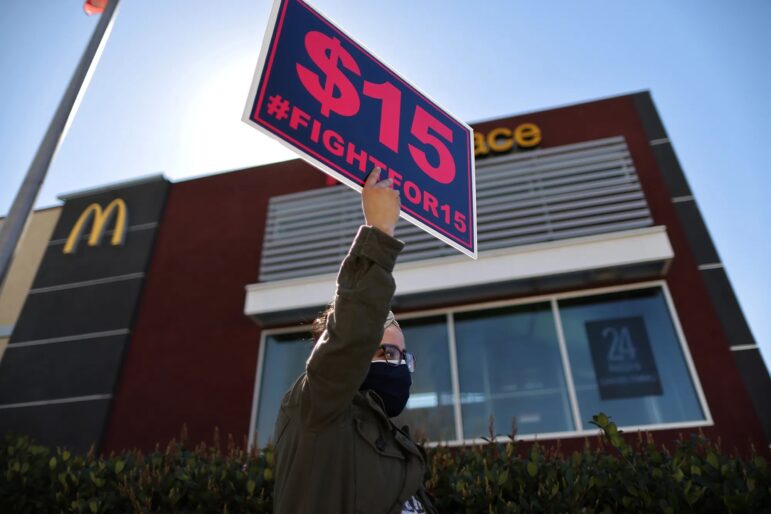Californians won’t vote this fall on whether the minimum wage should rise again as inflation continues to tear through families’ budgets.
An initiative to bump the minimum wage to $18 over the next three years, though bankrolled by a wealthy investor and backed by a slew of labor organizations, has failed to qualify for the November ballot.
The Secretary of State’s office said not enough signatures had been verified by county election officials by the Thursday deadline to qualify the measure.
Triggered by the record rate of inflation, which in the past year has caused the biggest increase in the consumer price index in four decades, California’s top-of-the-nation minimum wage already is set to increase to $15.50 an hour next January.
Had the California Living Wage Act proposal succeeded, it would have increased it to $16 next January and $18 by 2025, after which the minimum wage would have adjusted annually to account for the cost of living.
‘Empty stomachs’
Starting in February, the initiative campaign was among the later ballot efforts to begin collecting signatures this year. Joe Sanberg, a Los Angeles startup investor-turned-advocate against poverty, said he would spend what it took to get it on the ballot. He personally poured $10 million into the campaign, and supporters announced in May they had turned in more than a million signatures.
But the measure, which was opposed by a group of small business owners, fell victim to the time-consuming process of signature verification.
Supporters said they’re still trying to get the measure on the ballot this fall through “whatever legal means necessary.”
As of the Thursday night deadline, the measure was still awaiting signature verification from just a few larger counties such as San Diego, Kern and Sacramento that would likely put the measure over the threshold to qualify.
“Nothing should stand between working people and affording life’s basic needs — that includes meaningless bureaucracy,” said Anna Bahr, campaign spokesperson, in an email. “This is a wildly popular, morally righteous measure.”
It is likely to qualify for the ballot in 2024 — which would create a much quicker timeframe for the $18 wage to go into effect by 2025.
Sanberg, an early investor in the meal delivery service Blue Apron, has reportedly mulled a presidential run.
He also has pushed for other anti-poverty measures in Sacramento. And he lobbied for the creation of a state Earned Income Tax Credit, which gives as much as $3,000 a year to low-income workers, and he formed a group to help qualified residents get the benefit.
He announced the minimum wage campaign late last year as rising costs began to strain household budgets. Experts worry that inflation will offset strides the state made reducing poverty during the pandemic, largely from state and federal stimulus programs.
“That’s $24 of pay per day, or $6,240 in extra pay per year for millions of people,” Sanberg said of the $18 minimum wage in an interview in May. “It means the difference between kids going to school with empty stomachs or stomachs filled with healthy food, and means millions of families that will be able to afford rent or not afford rent.”
Recent price increases have hit the lowest wage earners the hardest, advocates said.

‘Fallout on Main Street’
But raising the minimum wage again would strain small employers, who also face rising supply costs and a tight labor market, said John Kabateck, state director of the National Federation of Independent Business’ California chapter, which represents about 15,000 small businesses.
Many employers already offer starting pay above the minimum wage, and raising the state minimum would force employers to boost the pay of higher-level employees, he said.
“We think this is an absurd proposal that keeps recurring again and again … without the understanding of the fallout on Main Street and businesses crawling out from the COVID hole,” he said.
The minimum wage is currently $15 an hour for most employees and $14 at businesses with 25 or fewer employees. The Legislature passed that wage hike in 2016, heading off a ballot measure spearheaded by unions that year.
The baseline was expected to increase Jan. 1, 2023 to $15 for employers of all sizes, but a 7% rate of inflation will instead push it to $15.50, the state Finance Department announced in May.
A hike to $18 by 2025 would not have been as dramatic a shift as it sounds. Under current law workers already could see a bump to $16 in 2024 if inflation forecasts hold true, wrote UC Berkeley economics professor Michael Reich in a policy brief this week.
And about a third of the state’s private-sector workers already are covered by some 37 local minimum wage ordinances that are higher than the state’s and that rise with inflation, Reich wrote.
He projected that an $18-an-hour statewide base wage would result in a raise for close to 5 million workers and cause an overall increase in restaurant and retail prices of less than 0.05% over three years.